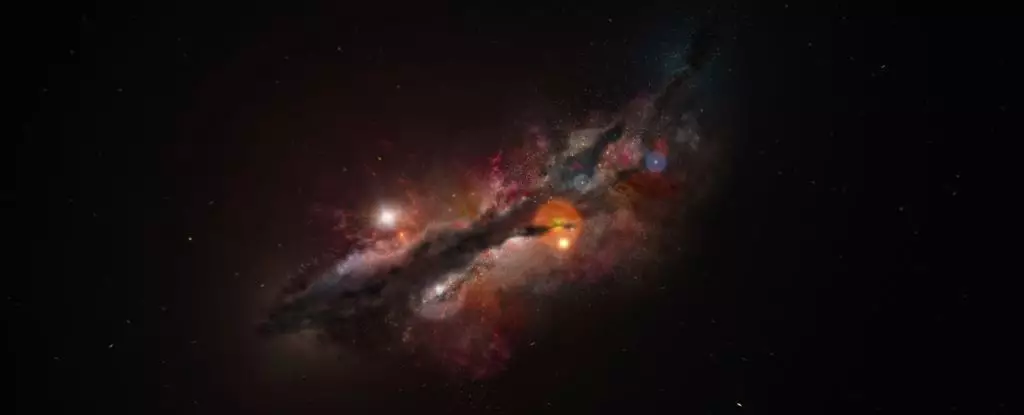In a groundbreaking revelation, astronomers have identified JADES-GS-z14-0, a galaxy that flaunts an unexpected richness in oxygen, just 300 million years after the Big Bang. This discovery starkly contrasts with longstanding assumptions in cosmology, which held that substantial quantities of heavier elements did not appear until much later in the universe’s timeline. The implications of this finding are profound, suggesting that the narrative of cosmic evolution needs to be rewritten.
The Challenge to Established Models
Traditionally, one of the foundational beliefs in cosmology is that the formation of galaxies requires a considerable amount of time. For JADES-GS-z14-0 to be visible to our current telescopes, it had to be both massive and luminous, raising questions about the evolution rate of galaxies. According to cosmologist Sander Schouws from Leiden Observatory, the speed of JADES-GS-z14-0’s development is akin to discovering an adolescent where only infants were expected. This remark aptly encapsulates the shock and awe that comes with such a groundbreaking observation, suggesting that the maturation of galaxies happened far more rapidly than scientists had anticipated.
The galaxy’s discovery challenged existing models of cosmic evolution—not merely because of its oxygen content but also due to its sheer luminosity and size. Galaxies of this sort were expected to take millions of years to solidify, yet here stands JADES-GS-z14-0, demanding a reevaluation of how we understand galaxy formation and evolution in the cosmos.
Oxygen: The Unexpected Element
One of the most fascinating facets of JADES-GS-z14-0 is its unexpected abundance of oxygen. In the aftermath of the Big Bang, hydrogen and helium were the first elements to emerge. Heavier elements arrived subsequently, as the universe’s early stars initiated nuclear fusion processes that ultimately led to their explosive deaths in supernovae. Only then were these heavier materials scattered throughout the galaxy, potentially giving rise to future generations of stars.
Researchers using the Atacama Large Millimeter/submillimeter Array (ALMA) in Chile found that JADES-GS-z14-0’s concentration of heavier elements was ten times greater than traditional models had predicted. This revelation rekindles our understanding of nucleosynthesis and how promptly these early stars were able to form the universe’s intricate chemical tapestry.
Astrophysicist Stefano Carniani from the Scuola Normale Superiore in Italy expressed astonishment at these findings, as they open new avenues for understanding the formative years of galaxies. His statement emphasizes that, if such galaxies were already exhibiting signs of maturity, we must fundamentally reassess not only when they formed but also by which mechanisms.
The Role of Advanced Technology
This groundbreaking discovery might not have been possible without the advancements in telescope technology, notably the James Webb Space Telescope (JWST). Launched with the mission to observe the universe’s most distant corners, JWST is the most advanced infrared telescope ever created. It specializes in capturing redshifted light, allowing astronomers to see galaxies that existed when the universe was still in its infancy.
Since its inception, JWST has altered our perception of the early universe, revealing a plethora of large galaxies much earlier than we ever thought possible. Each of these observations adds another piece to the cosmic puzzle, challenging and refining our understanding of galaxy formation during the universe’s formative years. JADES-GS-z14-0 is the latest and perhaps most striking example of how new data can lead to paradigm shifts in our cosmic narrative.
Implications for Cosmology
The discovery of JADES-GS-z14-0 serves as a stark reminder of how little we truly know about the early universe. The rapid evolution of such galaxies leads to intriguing questions about the overall cosmological timeline and whether current theories can accommodate these new realities. If galaxies did indeed form and mature faster than previously assumed, what does that indicate about the processes driving cosmic evolution? The existence of JADES-GS-z14-0 compels scientists to scrutinize and potentially revise their models, integrating new findings that suggest a more complex and nuanced picture of the universe’s infancy.
As more evidence surfaces, it is crucial for researchers to delve deeper into the mysteries surrounding galaxy formation and the distribution of elements in the early universe. The potential for new discoveries, such as those surrounding JADES-GS-z14-0, not only sheds light on our ancient past but also informs future explorations of the cosmos. The quest to unlock the universe’s secrets is far from over; rather, it is only just beginning.


Leave a Reply